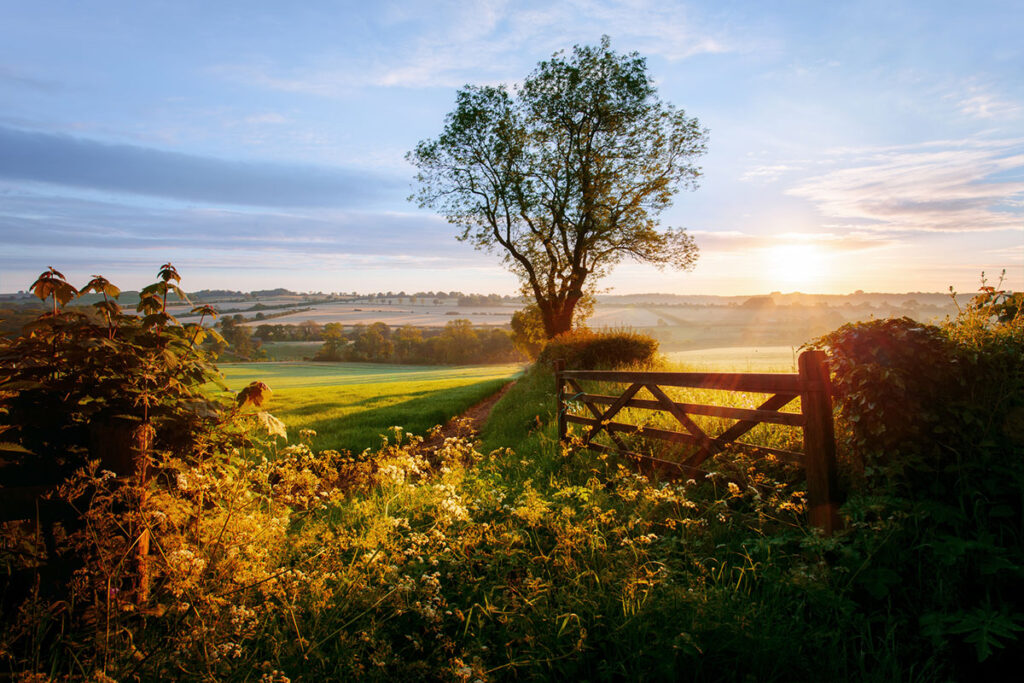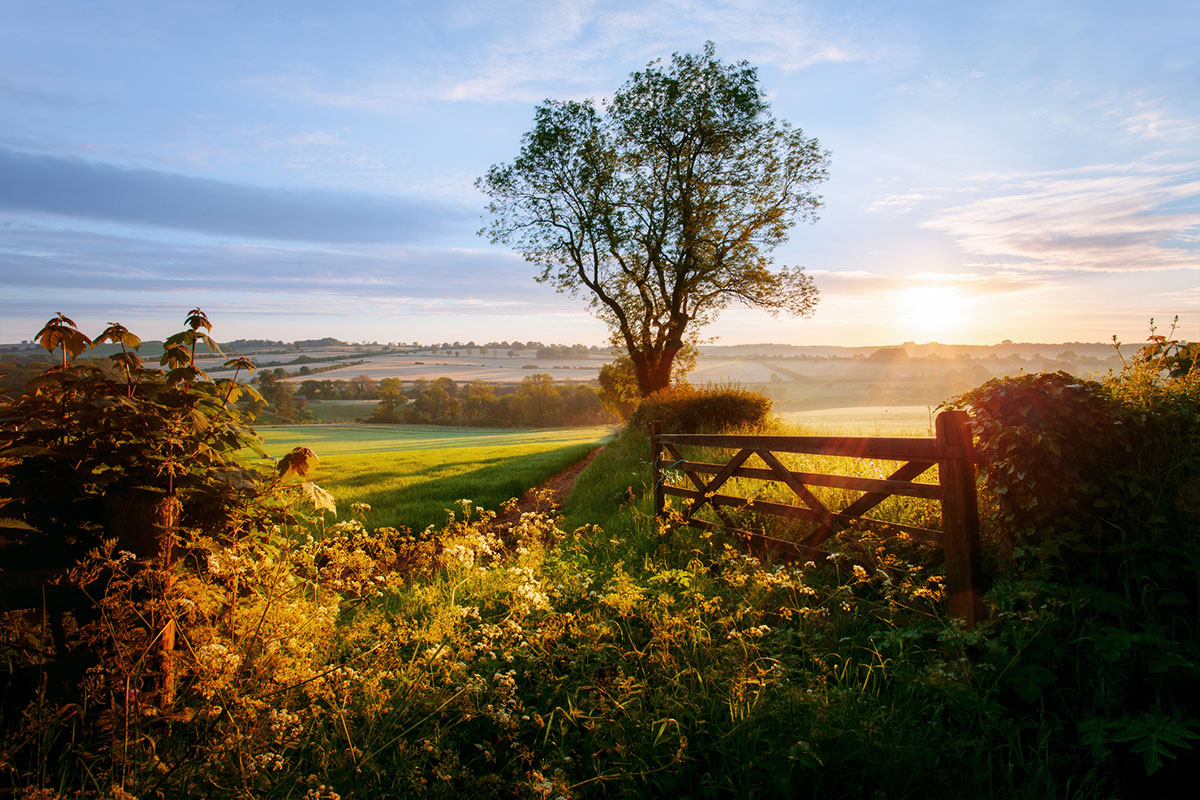Public rights of way can affect property owners in all manner of unforeseen ways, which is why it pays to have clarity on exactly how you can manage them on your land. Our Partners, Jemma Scott and Mark Lawson, share their expertise on how to ensure that the rights of way for which you are responsible feel less of a nuisance and more of an asset

There are over 140,000 miles of footpaths, bridleways and byways in England and Wales, many of which date back hundreds, even thousands of years. Carved into the landscape naturally by animal and human migration, they were later used for trade, farming, pilgrimage and recreation, and form an integral part of our heritage.
Yet for many rural homeowners or buyers of country properties, discovering a public right of way on your land, particularly if it runs in close proximity to the house, can be an unwelcome surprise. The idea of walkers, riders or even vehicles passing through your property can feel like an added complication to purchasing a dream home, and even an infringement on privacy and security. But with clarity, understanding and good management, living with a right of way can be harmonious – and sometimes even add value.
The Types of Rights of Way
Public rights of way are legally protected routes that the public can use to cross private land. There are several different categories in England, each with its own rules on usage.
Public footpaths
These are the most common type and may cross fields, meadows, or the edges of private gardens. They are only for walkers and people using mobility aids, such as wheelchairs or prams. Cycling or riding on a public footpath is not permitted unless the landowner gives permission.
Bridleways
Bridleways can be used by walkers, horse riders and cyclists. While cyclists have a right to use them, they must give way to other users. Motor vehicles are not allowed.
Restricted byways
These routes are open to walkers, cyclists, horse riders and horse-drawn vehicles, but not motor vehicles. They often follow old carriageways or drovers’ roads, which were routes to move livestock on foot.
Byways open to all traffic (BOATs)
Despite the name, BOATs are mainly used by walkers and riders, but motorised vehicles also have a legal right of access. Their presence can be more contentious, particularly where 4x4s or motorbikes use them recreationally.
Permissive paths
These are routes that a landowner has voluntarily allowed the public to use. They’re not legal rights of way, and the landowner retains the right to close or reroute them. Signage often indicates that they are permissive rather than statutory.
Open access land – The Countryside and Rights of Way Act 2000 (CROW)
The CROW Act gives the public a right to roam across designated open country, which includes mountain, moor, heath, downland and registered common land. This is a right of access on foot only and doesn’t necessarily follow marked paths. It doesn’t include gardens or land close to a house, and certain restrictions may apply during particular times, such as during lambing season or due to risk of fire.
Landowner’s responsibilities
Before buying a rural or semi-rural property, it’s essential to check whether public rights of way cross the land. “When we look at properties, of course we look at the house but – equally importantly – we look at what’s around it, what’s on it, what’s next to it and what’s adjacent to it. And a major part of that is rights of way,” says Jemma Scott, our North Home Counties Partner.
To identify these, we first look at an Ordnance Survey map. We then undertake a Highways Search which flags up what the local authority recognises are the definitive rights of way – some of which may not appear on a map.
However, there are estimated to be more than 40,000 miles of rights of way in England that are not officially recorded and it’s our job to try to identify those. As buying agents, we also search whether there are any current proposals to create new rights of way across a property.
Owning land with a public right of way brings legal responsibilities which are important to observe. You must keep the route open and unobstructed, which means gates must open freely, stiles must be safe and usable, paths must not be ploughed and vegetation should be kept trimmed.
It is also an offence to display misleading signs that might deter legal users – for instance, putting up ‘Private’ or ‘Keep Out’ on a public footpath. However, clear signage that distinguishes public paths from private driveways or gardens is entirely permissible and often helpful for everyone.
Where animals are grazed, additional precautions are required, such as keeping aggressive livestock away from paths, particularly during calving or lambing season. Or if there is an old listed wall that’s prone to collapse running alongside a footpath on your property, it needs to be carefully managed to avoid injury. In these instances, we would advise clients to take out public liability insurance.
Navigating more informal agreements
Permissive paths, by definition, are not statutory, so extra care should be taken to establish if these affect a property. “As soon as clients have bought a property, I always advise them to submit a section 31(6) Notice with a map attached illustrating the public rights of way that they accept and acknowledge on their land. This gets lodged with the council and once it’s confirmed and on record, there can’t be any other claims for any other right of way across the land. And you should make sure you have signage saying that access is by permission only,” advises Mark Lawson, our High Value & Rural Estates Partner.
Grey areas can also arise when neighbours, friends or villagers have more informal historical arrangements regarding rights of way over your property, which aren’t clearly stated on the title deed. “For instance, the owner of a private driveway may give their neighbour in the house at the end of it the right to use it to access their property,” says Jemma. “Or a property may have a beautiful parcel of land, but you need to know that a lady up the road has the right to motor across it to drove her sheep.”
If you become aware of such an informal agreement, we would always try to get the seller to formalise it before exchange, as Mark explains: “That means getting everyone to agree and sign a legally-binding document with a plan attached which clearly states that they have no legal right of way, it is by permission only.”
He adds: “I’ve come across it with very old estates which have been in the same family for generations where local villagers use a path around a field on its land and have done so for years. In this instance I would suggest having a licensing system in place so you write to them every year with a license or numbered ticket and a map, saying you’re allowing them the right to walk around this field but they have no formal rights to it and it can be withdrawn at any time.”
Diverting a right of way
Attempting to divert a footpath away from your property can be a very difficult process, which can often involve lengthy consultations with several different official bodies at a sizeable financial cost.
Jemma says: “I had a situation where we lost out on a house in sealed bids because a very wealthy, high-profile couple outbid everyone else by a significant figure because their London agent had told them that they would be able to move the footpath that ran directly past the front door and through the middle of the garden. Unfortunately for them, there was no way they were going to be able to do that and it caused all sorts of complications That’s why the right advice is so important.”
There are, in fact, certain circumstances in which you are more likely to be successful in diverting a footpath.
“It may be that there’s a footpath on your land running through the countryside with beautiful views, but it happens to go right through one of your best woods where you want to shoot. If you offer an alternative route along an old track with no views, then you will – almost certainly – have no chance at all,” says Mark. “On the flip side, if there’s a footpath going right through a really noisy, dangerous farmyard where you have lots of animals and machinery, and you offer an alternative route that’s safer, with better views and nicer countryside, you have a strong case.”
To begin the process, you would need to consult a Rights of Way Officer within the Local Authority or an expert in footpath diversions to help you take the appropriate next steps. We often make those connections and manage this process on behalf of our clients.
Jemma says: “If you want to buy a house that has a footpath that runs very close to the front door that you’ve never seen anyone use, don’t assume that people won’t. Some will, because they can. And if you try to block it without going through the appropriate channels, you will meet stern opposition from people who say they have every right to walk it.”
How to minimise their impact
Part and parcel of living in the countryside is that there will be some form of right of way nearby. “Sometimes the best houses have footpaths,” says Jemma. “The question is what it looks like in the sum of its parts. Is it a peripheral footpath, or does it come directly off your front drive?
“While you may have the right to fence off the right of way to shield it from view, if people have been using it for years to walk their dogs with unobstructed views, and suddenly they are in a little 2m-wide shovel-through, you’re not going to make any friends in the village,” she warns.
Thoughtful fencing or hedge planting can provide a sense of privacy, while still respecting access. While improving signage and waymarking at entry points encourages users to stay on track and follow The Highway Code. Regular maintenance prevents paths from becoming overgrown or boggy – conditions which can encourage trespassing onto unintended areas.
Seeing them as an asset
It’s important to remember that a well-maintained footpath or bridleway offers instant access to a huge network of walking, cycling or riding opportunities; connecting people to the land in the best sense.
“I’m working with a client at the moment whose son is a very keen cyclist and so it would be a real bonus to have good access to a bridleway from their property, so he can easily set off onto this network of paths,” says Mark. “As long as it’s not too close to the house itself, having that access the other side of your garden gate can be highly desirable.”
Jemma adds: “Current clients of mine are actively looking for access to bridleways and any search for an equestrian property will require the same. A large proportion of my clients also want access to walks – and therefore footpaths – from their property. It’s all part of the lifestyle that they’re buying into, especially if they’re moving out of a city.”
It’s not just our clients that enjoy this extensive network of rights of way. “I live just west of Marlborough in Wiltshire close to beautiful chalk hills which are crossed by the White Horse Trail and The Ridgeway – said to be the oldest road in Europe – where I walk every weekend. It’s absolutely stunning,” says Mark. “There’s Milk Hill with Alton Barnes White Horse cut into the chalk hillside and you can walk over the top of the horse, which is fantastic.”
“I live and work in the Chilterns which is awash with a myriad network of beautiful footpaths and bridleways,” says Jemma. “I also love walking in the Hambleden Valley across the Hamble Brook chalk stream and up into the hills and woods between Henley-on-Thames and Marlow. The 180-mile Thames Path which follows the river from its source in Gloucestershire right into London, is another firm favourite.”

Jemma Scott is The Buying Solution’s Partner in the North Home Counties

Mark Lawson is The Buying Solution’s Partner specialising in High Value Residential and Rural Estates
For news, expert commentary and invaluable property insight, subscribe to The Insider, our quarterly newsletter, here.
